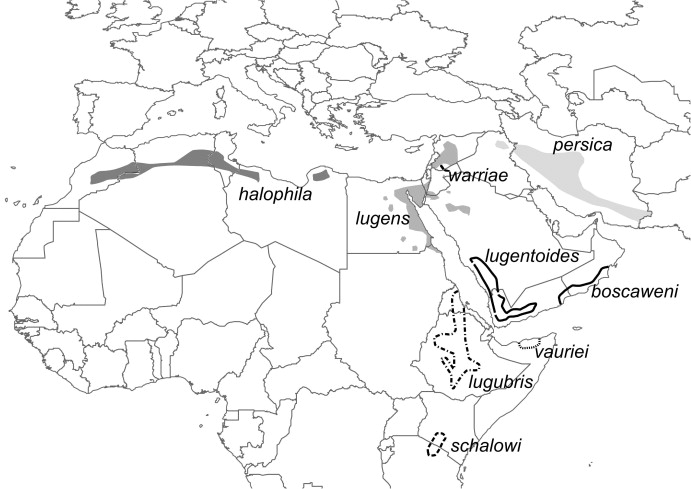A new phylogenetic study of the Mourning Wheatear complex confirmed its split into three different species. Concerning the Maghreb Wheatear, which is already given species status by some authors, the new study hinted that it should be split too.
The Mourning Wheatear (Oenanthe lugens) senso lato is distributed in North Africa, East Africa, the Levant, Iran and the Arabian Peninsula (NW plus C and SW). Based on morphological characters, eight to nine subspecies – divided into three groups – have been traditionally recognized. Moreover, this species complex has been also treated in the past as conspecific with Finsch’s wheatear (Oenanthe finschii).
Using both mitochondrial and nuclear DNA, the new phylogenetic study by Schweizer and Shirihai (2013) found the species complex to be polyphyletic (meaning the different taxa should not be included in the same species, thus the need to split the species complex). The study identified two major clades:
- The first clade included the Finsch’s Wheatear, Kurdish Wheatear (O. xanthoprymna), Red-tailed Wheatear (O. chrysopygia) and four taxa of the Mourning Wheatear (lugens, warriae, halophila and persica). In the phylogenetic tree, Finsch’s Wheatear is sister to a group comprising Kurdish Wheatear and Red-tailed Wheatear in one hand and a group that includes the four Mourning Wheatear taxa on the other hand.
- The second major clade consisted of two well supported sister groups: the East African taxa (lugubris, schalowi and vauriei) and the Arabian taxa (lugentoides and ‘boscaweni’).
The suggested split
In summary, the study recommended splitting of the Mourning Wheatear complex into the following three species. This is the treatment already followed by IOC Checklist since at least 2012 based on previous studies (e.g. Förschler et al. 2010), and this study confirm this three-way split:
- Mourning Wheatear (Oenanthe lugens): with subspecies persica, halophila, lugens and warriae.
- Arabian Wheatear (Oenanthe lugentoides): with subspecies lugentoides and the weekly differentiated and probably invalid ‘boscaweni’.
- Abyssinian Wheatear (Oenanthe lugubris): with subspecies lugubris, vauriei and schalowi.
What about the Maghreb Wheatear and persica?
Concerning the taxon persica (which, as the name suggest, breeds in Iran), the authors noted that further studies are needed to assess the merit of its species status as proposed by a previous study (Förschler et al. 2010).
Concerning the North African taxon halophila, the authors noted:
Although halophila and lugens have only very recently separated, the former is unique among the taxa of the lugens group in showing strong sexual dimorphism. Moreover, males can be constantly separated by plumage characteristics from lugens and persica and halophila differs slightly in vocalizations from lugens (Shirihai et al. 2011, Shirihai and Svensson, in prep.). This could be taken as evidence that halophila might have reached reproductive isolation from O. lugens and should be considered a species in its own right, i.e. Maghreb Wheatear Oenanthe halophila.
I think that the Maghreb Wheatear should be treated as a distinct species because the genetic data does not always tell the whole story. There are many cases of taxa elevated to species rank although, like the Maghreb Wheatear, they lack genetic differentiation from the “parent species”. In the genus Oenanthe, Cyprus Wheatear (O. cypriaca) is a good example. Despite its lack of mtDNA differentiation from the Pied Wheatear (O. pleschanka), it’s treated as a distinct species based on other characters (song, behaviour, morphology…).
The differences summarized by the authors above (for more details see: Boon 2004) plus geography should be enough to treat the Maghreb Wheatear as a distinct species in an integrative approach toward species delimitation (Helbig et al. 2002, Tobias et al. 2010). This approach has been successfully applied in other cases such as the Cyprus Wheatear as mentioned above and the African crimson-winged Finch (Rhodopechys alienus) just to cite a few examples.
References:
Boon, L. J. 2004. ‘Mourning Wheatears’ illustrated. Dutch Birding 26: 223-236.
Förschler, M.I., Khoury, F., Bairlein, F. & Aliabadian, M. 2010. Phylogeny of the mourning wheatear Oenanthe lugens complex. Molecular Phylogenetics and Evolution 56: 758–767. doi: 10.1016/j.ympev.2010.03.022
Schweizer, M. & Shirihai, H. 2013. Phylogeny of the Oenanthe lugens complex (Aves, Muscicapidae: Saxicolinae): Paraphyly of a morphologically cohesive group within a recent radiation of open-habitat chats. Molecular Phylogenetics and Evolution 69: 450–461. doi: 10.1016/j.ympev.2013.08.010
Recognising the split of the Maghreb Wheater:
Collins Bird Guide (Lars Svensson et al.) and the Dutch Birding Association have already split the Maghreb Wheatear before this study, see Boon (2004) for example.
Updates:
The Swedish Taxonomic Committee split the Maghreb Wheatear in 2014.

